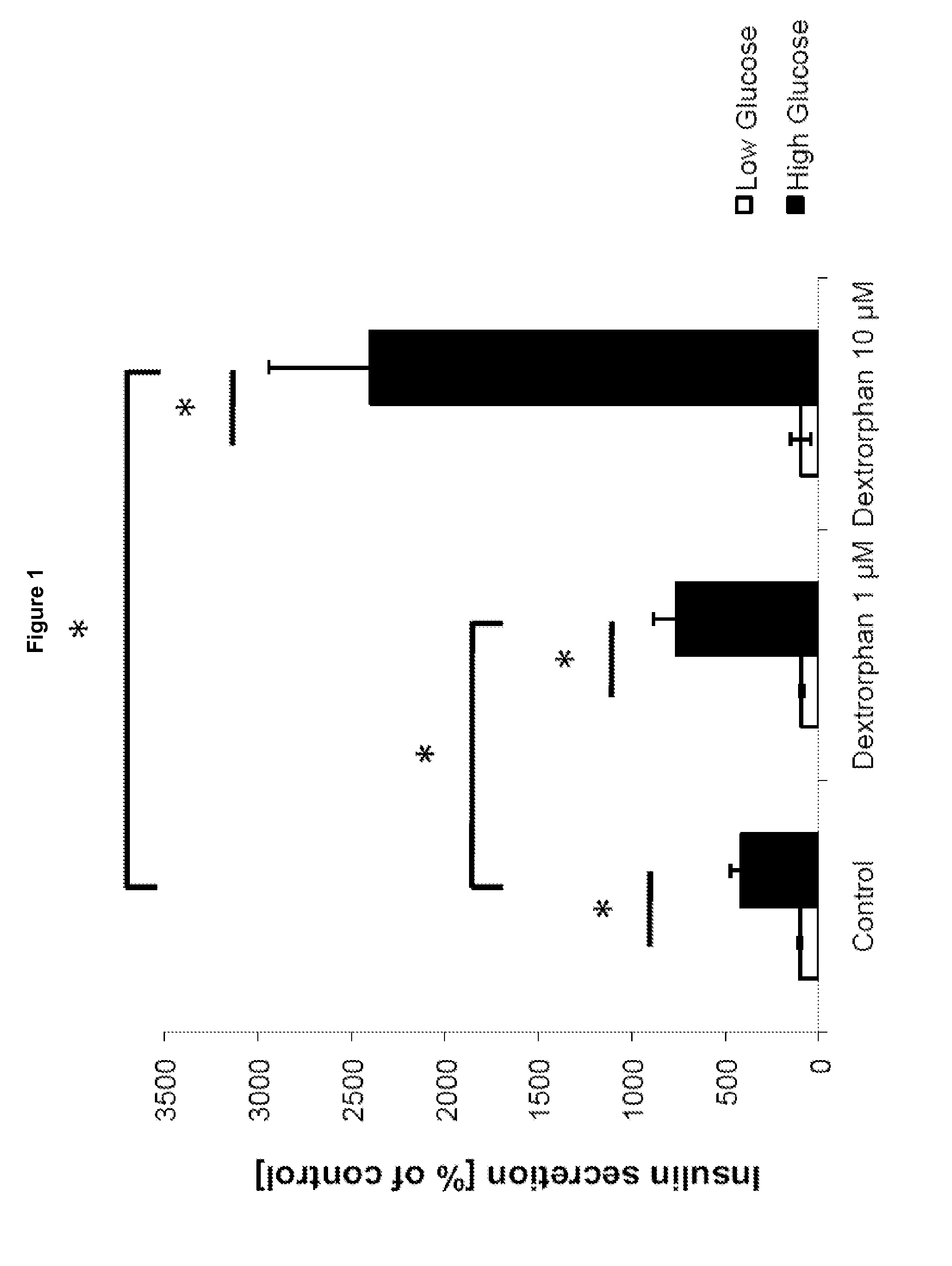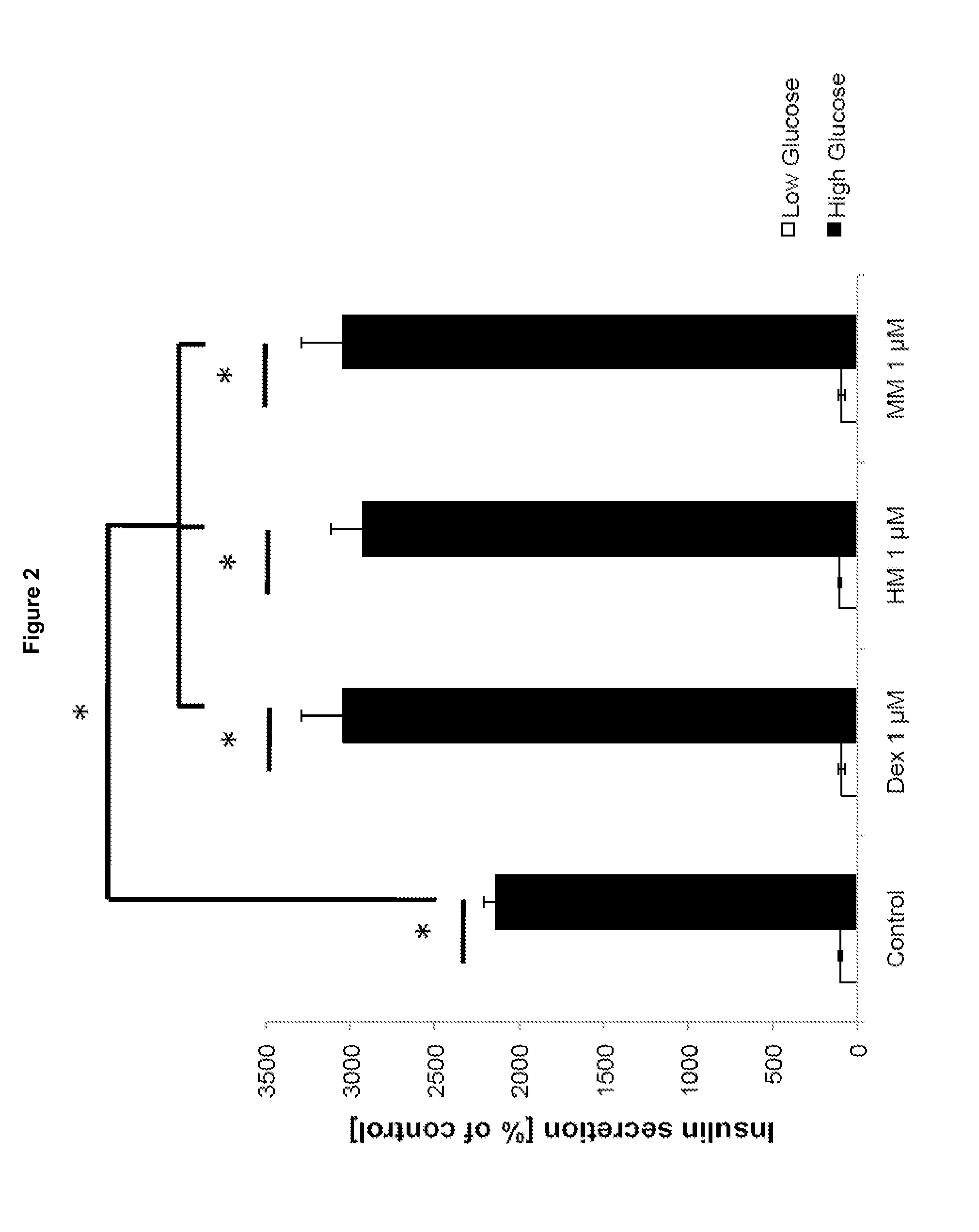Morphinan-derivatives for treating diabetes and related disorders
a technology of morphine and derivatives, applied in the field of morphineanderivatives, can solve the problems of retinopathy, nephropathy, even renal failure, and the current oral antidiabetic drug available in germany is problematic and not satisfactory in every respect, so as to slow down the progression of type 2 diabetes and prevent or retard the subsequently necessary administration of sulfonylurea or insulin.
- Summary
- Abstract
- Description
- Claims
- Application Information
AI Technical Summary
Benefits of technology
Problems solved by technology
Method used
Image
Examples
example 1
[0162]Mouse pancreatic islets were treated with a low, non-stimulatory glucose concentration (2.5 mM) or a high, stimulatory glucose concentration (25 mM) in the absence or presence of 1 μM or 10 μM dextrorphan. Insulin secretion was determined as percent of 2 mM glucose control, and values are expressed as means+ / −SD (N=3). The asterisks (*) indicate p values smaller than 0.05 in Student's t-tests.
[0163]FIG. 1 shows insulin secretion from mouse pancreatic islets in the presence and absence of dextrorphan. Low Glucose (2.5 mM); High Glucose (25 mM); p<0.05 (Student's t-Test), N=3.
[0164]As can be seen, insulin secretion is selectively increased at a high rather than low glucose concentration.
example 2
[0165]Mouse pancreatic islets were treated with a low, non-stimulatory glucose concentration (2.5 mM) or a high, stimulatory glucose concentration (25 mM) in the absence or presence of 1 μM or 10 μM compound (dextromethorphan, 3-hydroxy-morphinan and 3-methoxy-morphinan). Insulin secretion was determined as percent of 2 mM glucose control, and values are expressed as means+ / −SD (N=3). The asterisks (*) indicate p values smaller than 0.05 in Student's t-tests.
[0166]FIG. 2 shows insulin secretion from mouse pancreatic islets in the presence and absence of dextromethorphan (Dex), 3-hydroxy-morphinan (HM) and 3-methoxy-morphinan (MM). Low Glucose (2.5 mM); High Glucose (25 mM); p<0.05 (Student's t-Test), N=3.
example 3
[0167]Fasted 8 week-old male mice C57BL / 6 received an i.p. injection of glucose (2 mg per g (body weight)) at the point of time 0′ minutes (control) or glucose together with dextrorphan (40 μg per g (body weight)) (DXO group) at the point of time 0 minutes. Blood glucose levels were determined at the indicated times in FIG. 3. Values are expressed as means±SD (n=6 per group), DXO dextrorphan. P values with Student's t-test.
PUM
| Property | Measurement | Unit |
|---|---|---|
| weight | aaaaa | aaaaa |
| particle size | aaaaa | aaaaa |
| insulin resistance | aaaaa | aaaaa |
Abstract
Description
Claims
Application Information
 Login to View More
Login to View More - R&D
- Intellectual Property
- Life Sciences
- Materials
- Tech Scout
- Unparalleled Data Quality
- Higher Quality Content
- 60% Fewer Hallucinations
Browse by: Latest US Patents, China's latest patents, Technical Efficacy Thesaurus, Application Domain, Technology Topic, Popular Technical Reports.
© 2025 PatSnap. All rights reserved.Legal|Privacy policy|Modern Slavery Act Transparency Statement|Sitemap|About US| Contact US: help@patsnap.com



